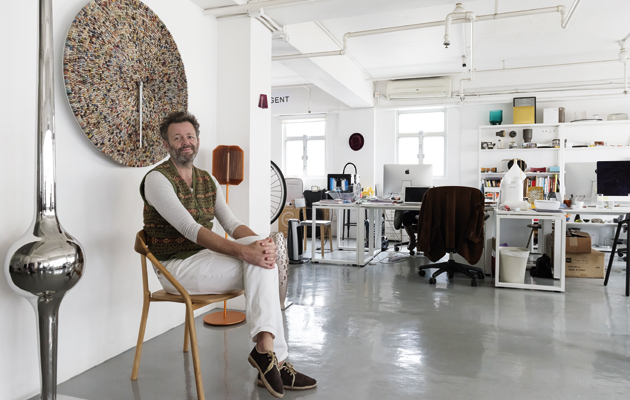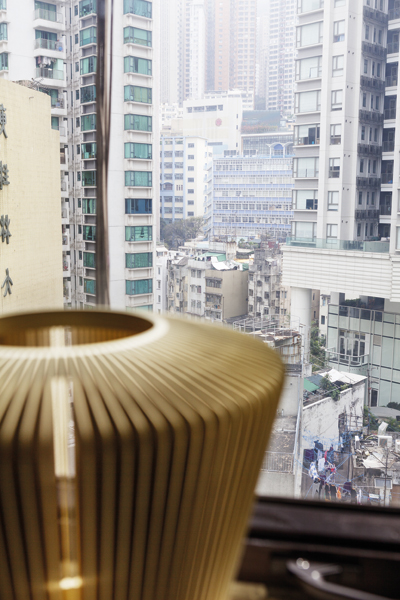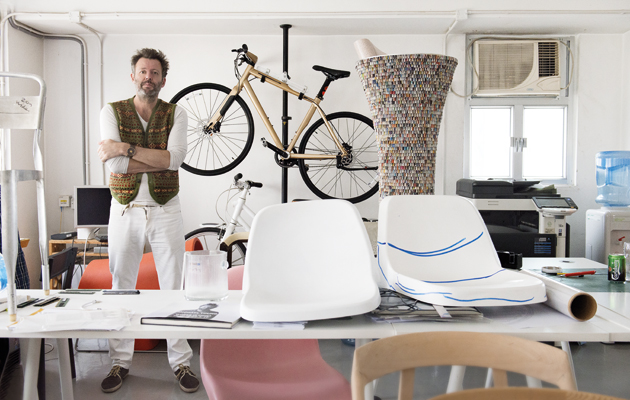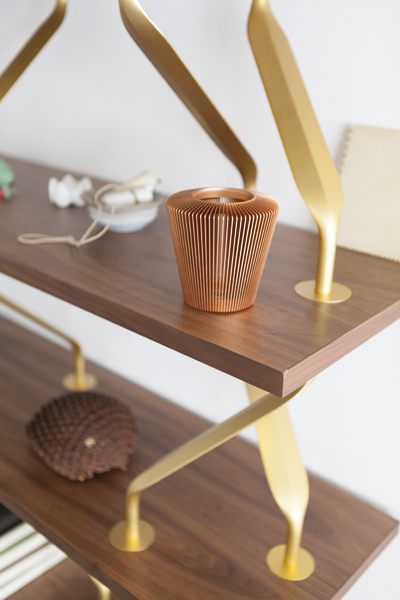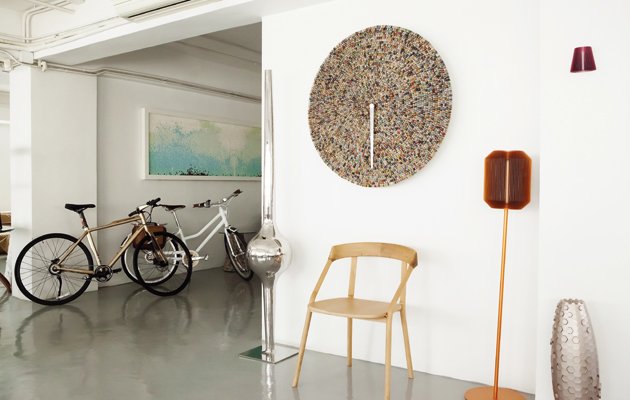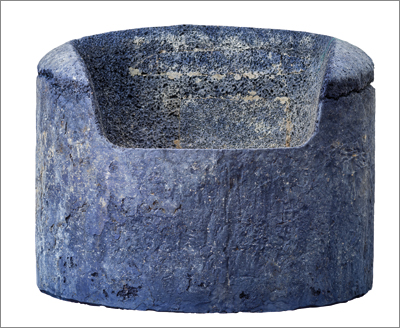|
|
||
|
When Michael Young moved to Hong Kong nine years ago, he was virtually a lone presence on the design scene. But life there has been liberating for the former enfant terrible. China allows him to design “ridiculous things” and work with manufacturers that have a passion for making them After threading across a pavement covered in drying seafood, then squeezing up narrow entrance stairs into a sweaty little lift, I’d been expecting something rather more bohemian. In fact, Michael Young’s Hong Kong studio is compact, open-plan and pretty much like any other design start-up, with its chaste scattering of Macs sitting amid a selection of the 48-year-old designer’s creations, old and new. The space is 11 floors up, and brightly lit by a large strip window that frames a view over the dense hill of concrete rising up the side of Hong Kong Island. Another, smaller window opposite looks out over Victoria Harbour.
The studio offers sweeping views over the concrete jumble of Sheung Wan The decaying postwar industrial building in Sheung Wan where Young has been ensconced since 2009 now houses tea merchants, shippers and the odd illegal resident, along with a creeping influx of “creatives”. The dormitory for prostitutes moved out a few years ago, which helped make client visits a more manageable proposition. At ground level, dried-seafood wholesalers still do good business – this is one of the few areas in central Hong Kong that remains socially and culturally diverse, despite the spillover of French hipsters from neighbouring “PoHo”. Its brushed aluminium furniture was first produced for a local restaurant commission and has now been adopted by Qantas and Barclays, while its precise, finned table lamps and pendant lighting, extruded from sold blocks of recycled metal across the border in Shenzhen, are on display around the studio. Hanging from a wall rack on my right is Young’s 2009 City Speed bike for Taiwanese manufacturer Giant, with its inbuilt LED lights and evolving top bar. Updated versions are currently being launched in Shanghai, with new projects also under discussion.A bunch of staff and interns tap politely at keyboards as I wait for Young but, as the minutes pass, it’s becoming clear this will be a no-show – it’s somehow reassuring that vestiges of Young’s past as an enfant terrible of the 1990s design scene remain. I track him down at a bar across town a couple of days later. |
Words John Jervis
Photography Inga Beckmann |
|
|
||
|
A cluster of newly delivered Yi chairs for EOQ (2013) |
||
|
The student protests have messed with his schedule and humour – on arrival he cancels a flight that evening to Brussels, where he has storage and another office, professing exhaustion. Thankfully, his amiability soon returns – the waiters resolutely ignore his efforts to order a beer, leading to prolonged lamentations: “Oh God, I’m a charisma-free zone …” As we talk, it swiftly becomes evident he’s still immensely grateful for what Hong Kong has done for him since he moved from Taiwan in 2006: “I was coming over at weekends and realised that Hong Kong was a portal, with access to the manufacturing facilities of Shenzhen, and on to China. I saw the big lights and thought, ‘OK, you have a town full of bankers on one side, and one full of industry on the other, this just has to be a good thing.’ It was intuition really.”
Various Michael Young creations, including wireless speakers and a shoe horn, lined up along the studio’s main window Young’s first Hong Kong studio was a couple of minutes from his current space, in an area now swamped by boutiques and cafes, but then a haven for local businesses and workshops. His little team was reduced to drinking beers in the local park for recreation, and he found himself pretty much a lone voice in the design field. Many Asian manufacturers had been burnt by past experiences of working with large, expensive American industrial design firms, yet they soon found Young’s hands-on approach far more to their liking. His mask of humility slips for a moment as he recalls being told recently that his arrival parted the waters for design in the region: “I guess I came in rather seamlessly under the radar, started doing my thing – I wasn’t an arsehole, wasn’t wearing a suit, people trusted me, and slowly I just connected with the right people.” |
||
|
Young stands in his lair, with his famous orange Magis dog house directly behind him |
||
|
In return, Hong Kong has adopted him – he has become the go-to guy both for young designers and for local companies ranging in size from luggage specialist Zixag right up to Cathay Pacific. “Before I knew it, everyone was calling me asking for advice – students, magazines, firms. The balance of my commissions has been getting more ‘East’ ever since.” As a sign of this adoptee status, the city’s ambitious new museum of visual art, M+ – due to open in its Herzog & de Meuron home in 2018 – has already acquired his personal archive, stretching right back to the 1994 Magazine sofa, which, as he blithely exclaims, “looks like a piece of shit now!” The ascendancy of design culture in Hong Kong right now is exemplified by the opening of the PMQ complex. A lavish conversion of an old police dormitory in the centre of town, it contains around 100 design shops and studios, including an EOQ outlet, alongside restaurants and event spaces. The willingness of Asian manufacturers to invest in experimentation remains a real pull for Young: “My sustenance in Asia has been the thirst from industry to invest in the things that I’m doing – I like the historic brands in Europe, but what China allows me to do is design something that I want to make, and then get a lot of heads being scratched saying, ‘How can we make this work for Michael?’ They have a passion for proving that they can do something in a new way. I’m trying to explore processes that are in a state of discovery, instead of just injecting a plastic chair, which you could do anywhere. And I’ve been very lucky – I’ve designed some ridiculous things and had them made. Asian manufacturers are keen to do something that they consider worthwhile, but their expectations keep getting higher, so the pressure on me just increases.” |
||
|
The limited-edition Newspaper bird house (2011) |
||
|
Despite these attractions – as well as the “pragmatic approach to tax,” as Young puts it, and the sheer sense of liberation that comes with living in Hong Kong – working in the city does take its toll. The constant noise; the grind of trekking out to industrial facilities deep in the Chinese countryside; restricted budgets for interior projects due to punishing rents; and even the mildew that grows on the back of his art collection are all mentioned. In particular, the difficulty of escaping to nature can be wearing – the Sunderland-born designer has recurring fantasies of retreating to a cottage in Devon with a bunch of dogs. His creative process, which once centred on long walks, is now focused on his house in the upmarket residential district of Happy Valley. He bought it six years ago due to a “very British sense of resentment” at spiralling rents: “It’s a cliche, I’ve packed it with furniture I’ve bought over time that I’m interested in – Carl Hansen, Hans Wegner, stuff like that.”
Young’s aluminium Bramah pendant (2012) on Bayer shelving (2013) When we meet, he is focused on producing Oxygen and Hex, two very different Chinese-made furniture editions, both of which apply experimental, and expensive, processes to aluminium – one involves the injection of gas under extreme pressure at 800ºC, the other employs a 5-axis CNC machine. Both were presented by San Francisco gallery Hedge at FOG Design+Art this January: “That’s where my heart lies – it’s what I started doing when I left college, and it takes you back to the things that you shouldn’t really make, that shouldn’t really exist. You discover all of these processes and all of a sudden you think, ‘Well that would work, but who would buy it at that price?’ I get a lot of support here in China, and I’ve finally found a gallery, Hedge, that wants to work with me in the way that I want to work – we just get on all the time.” When we meet, the plans are still under wraps, but he does concede, “I’m absolutely shitting my pants – you do things that you love, but you do realise that they |
||
|
The entrance is lined with Giant bikes, and a Newspaper clock (2011) hangs on the wall |
||
|
This vulnerability to criticism is evident throughout our conversation – Young has been burned in the past by being a little too frank, which results in occasional reticence towards my questions. He also admits to being hurt when he finds himself “shot from all sides” online, joking about his dark nights of the soul trawling the internet. To cheer him up, I pull out my old PX-5 watch, now mouldy from neglect and the Hong Kong climate. This classic was recently put back in production by the entrepreneurial Young, but he’s reluctant to take on the administrative burden and constant self-promotion of an “MY” brand, despite occasional offers. “I want my work to brand me, rather than vice-versa,” he says. “I refuse to do that.” Similarly, his willingness to take on specialist projects, such as his restrained, intelligent design for a public toilet in a Beijing hutong, still under development, is admirable: “It would have been so easy for me to do some extravagant sculptural form, but I went to see the site and there were all the old ladies coming out in their pyjamas, I almost started crying. They really do live like this – I just thought you have to develop the place, rather than do anything that is unfair to them.” We order a last drink and get down to the important matter of discussing the tedium of enforced visits to the region’s innumerable panda enclosures. Young denounces the iconic beasts as “so dirty and so yellow, just sprawling about on the ground all the time, eating”. Fortified by such outpourings, Young gets on the phone, rebooks his flight to Brussels, orders a taxi, downs his beer and, with impressive vigour, he’s off to the airport. Michael Young spoke at Icon’s House of Culture during Clerkenwell Design week on 20 May 2015
This year’s Oxygen chair for Hedge |
||

